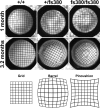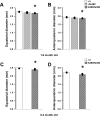Physiological and Optical Alterations Precede the Appearance of Cataracts in Cx46fs380 Mice
- PMID: 28810266
- PMCID: PMC5558631
- DOI: 10.1167/iovs.17-21684
Physiological and Optical Alterations Precede the Appearance of Cataracts in Cx46fs380 Mice
Erratum in
-
Erratum.Invest Ophthalmol Vis Sci. 2017 Sep 1;58(11):4799. doi: 10.1167/iovs.17-22948a. Invest Ophthalmol Vis Sci. 2017. PMID: 28973336 Free PMC article. No abstract available.
Abstract
Purpose: Cx46fs380 mice model a human autosomal-dominant cataract caused by a mutant lens connexin46, Cx46. Lenses from Cx46fs380 mice develop cataracts that are first observed at ∼2 months in homozygotes and at ≥4 months in heterozygotes. The present studies were conducted to determine whether Cx46fs380 mouse lenses exhibited abnormalities before there are detectable cataracts.
Methods: Lenses from wild-type and Cx46fs380 mice were studied at 1 to 3 months of age. Connexin levels were determined by immunoblotting. Gap junctional coupling was calculated from intracellular impedance studies of intact lenses. Optical quality and refractive properties were assessed by laser scanning and by photographing a 200-mesh electron microscopy grid through wild-type and Cx46fs380 mouse lenses.
Results: Connexin46 and connexin50 levels were severely reduced in mutant lenses. Gap junctional coupling was decreased in differentiating and mature fibers from Cx46fs380 lenses; in homozygotes, the mature fibers had no detectable coupling. Homozygous lenses were slightly smaller and had reduced focal lengths. Heterozygous and homozygous lenses significantly distorted the electron microscopy grid pattern as compared with wild-type lenses.
Conclusions: Before cataract appearance, Cx46fs380 lenses have decreased gap junctional conductance (at least in heterozygotes) and alterations in refractive properties (heterozygotes and homozygotes). The decreased focal distance of Cx46fs380 homozygous lenses is consistent with an increase in refractive index due to changes in cellular composition. These data suggest that Cx46fs380 lenses undergo a sequence of changes before the appearance of cataracts: low levels of connexins, decreased gap junction coupling, alterations in lens cell homeostasis, and changes in refractive index.
Figures







References
Publication types
MeSH terms
Substances
Supplementary concepts
Grants and funding
LinkOut - more resources
Full Text Sources
Other Literature Sources
Medical
Molecular Biology Databases
Miscellaneous

